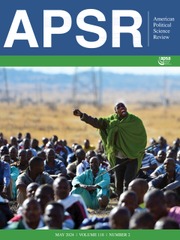Article contents
Geography, Transparency, and Institutions
Published online by Cambridge University Press: 07 June 2017
Abstract
We propose a theory in which geographic attributes explain cross-regional institutional differences in (1) the scale of the state, (2) the distribution of power within state hierarchy, and (3) property rights to land. In this theory, geography and technology affect the transparency of farming, and transparency, in turn, affects the elite’s ability to appropriate revenue from the farming sector, thus affecting institutions. We apply the theory to explain differences between the institutions of ancient Egypt, southern Mesopotamia, and northern Mesopotamia, and also discuss its relevance to modern phenomena.
- Type
- Research Article
- Information
- Copyright
- Copyright © American Political Science Association 2017
Footnotes
We have benefited from comments from Daron Acemoglu, Bob Allen, Josh Angrist, Ernesto Dal Bo, Eddie Dekel, Diana Egerton-Warburton, Christopher Eyre, James Fenske, Oded Galor, Maitreesh Ghatack, Jeremy Greenwood, Avner Greif, James Malcomson, Andrea Matranga, Jacob Metzer, Stelios Michalopoulos, Motty Perry, Torsten Persson, Herakles Polemarchakis, Louis Putterman, Debraj Ray, Ariel Rubinstein, Yona Rubinstein, Larry Samuelson, Matthew Spigelman, Yannay Spitzer, Nathan Sussman, Juuso Valimaki, Joachim Voth, and David Weil, and from comments from participants in various seminars and conferences.
References
REFERENCES
- 51
- Cited by



Comments
No Comments have been published for this article.